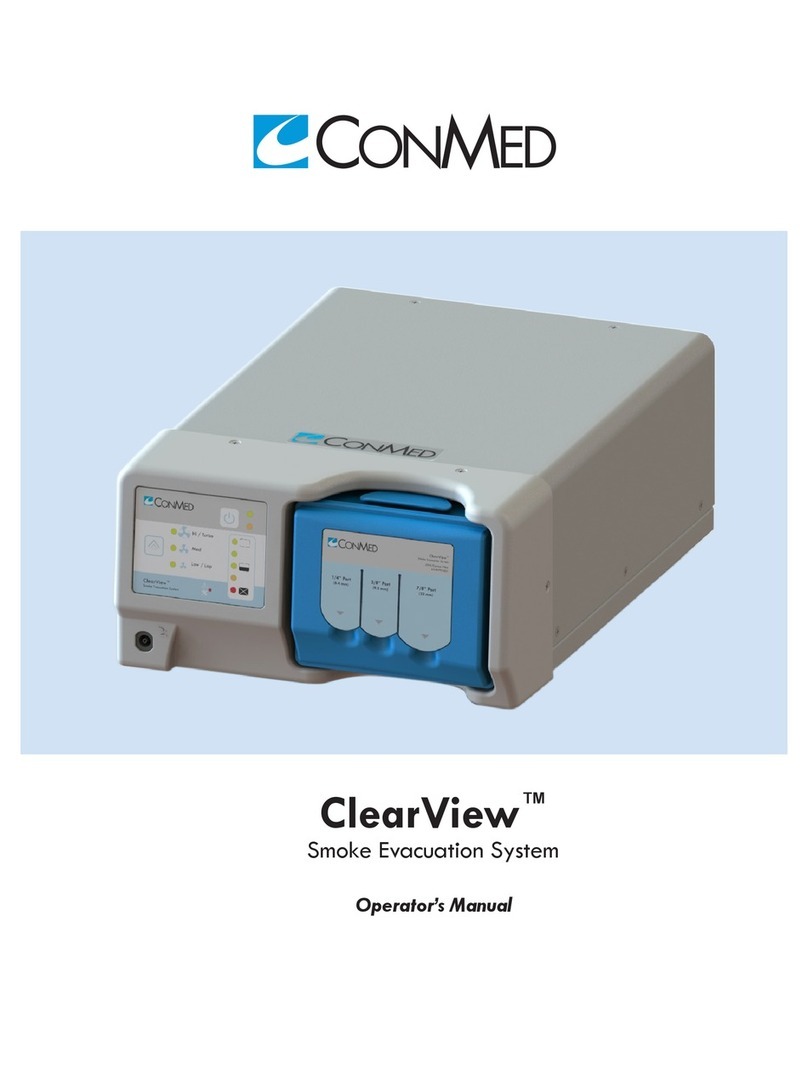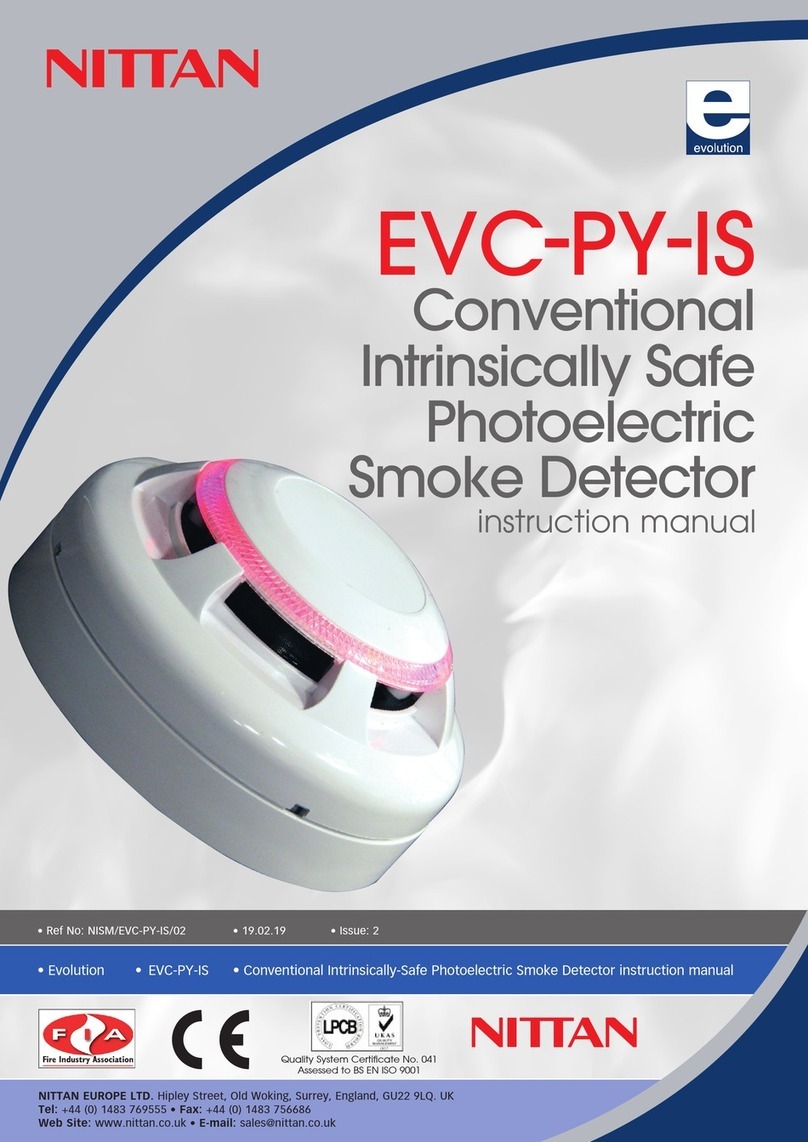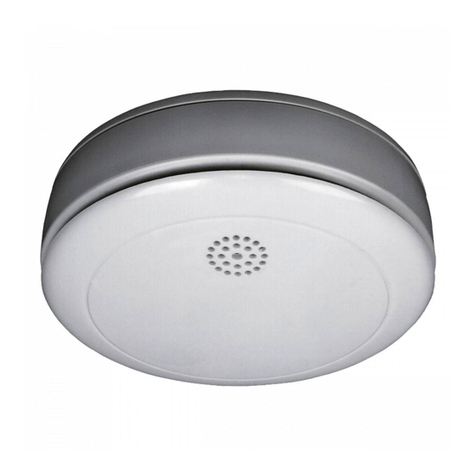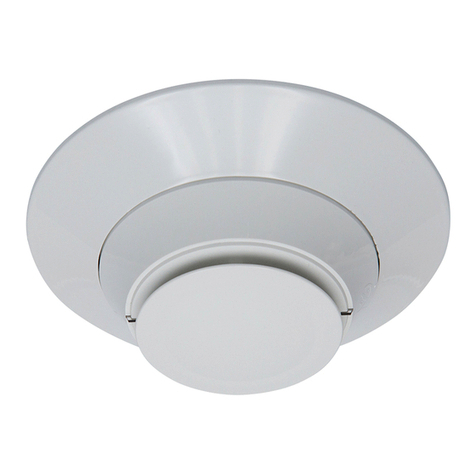Thorn security MR300 User guide

DOCUMENT CONTROL NUMBER /
© 1997 Thorn Security Limited PAGE 1 of 7
M300 SERIES
01A-02-D4
02 2/97
Registered Office: Security House The Summit Hanworth Road Sunbury-on-Thames Middlesex TW16 5DB
EQUIPMENT:
PUBLICATION:
ISSUE No. & DATE:
MR300 OPTICAL SMOKE DETECTOR RANGE
PRODUCT APPLICATION & DESIGN INFORMATION
1. INTRODUCTION
The MR300 range of optical smoke detectors forms part of the
M300 series of plug-in detectors for ceiling mounting. The
range is intended for two-wire operation on the majority of the
control equipment currently manufactured by the company. De-
tectors having different smoke sensitivities are offered as is an
intrinsically-safe type for use in hazardous atmospheres.
2. OPERATING PRINCIPLE
2.1 OPTICAL SYSTEM
Detectors in the MR300 range detect visible particles produced
in fires by using the light scattering properties of the particles.
All detectors in the range use the same optical system which is
shown diagrammatically in Fig. 1.
The optical system consists of an emitter and sensor, with a lens
in front of each, so arranged that their optical axes cross in the
sampling volume. The emitter, with its lens, produces a narrow
beam of light which is prevented from reaching the sensor by
the baffles. When smoke is present in the sampling volume a
proportion of the light is scattered, some of which reaches the
sensor. For a given type of smoke,
the light reaching the sensor is proportional to the smoke den-
sity. The output from the sensor can be used to activate an
alarm circuit at a pre-determined threshold.
2.2 FEATURES OF MEASURING CHAMBER
In order to make a practical smoke detector which uses the type
of optical system described above, great care is needed in the
design of the housing. Both the optical components and the
sampling volume must be protected from the environment but
still allow smoke to enter freely into the sampling volume. The
housing must also be designed in such a way that dust settling
on its surfaces will not scatter so much light into the sensor that
false alarms are generated.
The emitter is a Gallium Arsenide [GaAs] solid state type op-
erating at a wavelength of 0.94µm; the sensor is a silicon pho-
todiode. These devices with their associated lenses are held
within the optical array which also provides the baffles of
Fig.1. The design of this assembly is such that the presence of
very small insects [e.g. thrips] will not cause false alarms.
Fig. 1 M300 Detector Range, Optical System

PAGE 2 of 7
M300 SERIES
01A-02-D4
002 02/96
Fig. 2 Measuring Chamber Showing Smoke Flow Path
2.3 CIRCUIT OPERATIONS
A simplified block schematic of the detector is given in
Fig.3.
2.3.1 GENERAL
The GaAs emitter is pulsed every 10s in order to reduce its
power consumption. The pulse signal, as received by the sil-
icon photodiode, is fed to a high-gain amplifier. If smoke is
present, the pulse signal received varies in proportion to the
smoke density. The output of the amplifier is thus propor-
tional to the smoke density.
Detectors in the MR300 Range use the unique measuring
chamber shown in Fig.2.
The Sampling Volume is enclosed within a measuring cham-
ber formed by conical labyrinth mouldings. The optical de-
sign of the chamber provides a very low background signal
in clean air conditions even when the chamber is contami-
nated by white dust. This high tolerance to dust is improved
even further by an aerodynamic design which encourages
dust settlement to occur on the less critical optical surfaces.
The design of the measuring chamber is patented in the UK
under the number GB 2170597 and in the USA under the
number US 4728801.
Fig. 3 Schematic Diagram of Detector

© 1997 Thorn Security Limited PAGE 3 of 7
Registered Office: Security House The Summit Hanworth Road Sunbury-on-Thames Middlesex TW16 5DB
M300 SERIES
01A-02-D4
02 2/97
EQUIPMENT:
PUBLICATION:
ISSUE No. & DATE:
Fig. 4 Exploded View of the MR300 Type Detector

PAGE 4 of 7
M300 SERIES
01A-02-D4
002 02/96
The amplifier output is fed to a pulse height discriminator
which compares the signal with a preset threshold level. So-
phisticated synchronous detection techniques are used to
eliminate virtually all the effects of noise and spurious tran-
sients.
If the signal amplitude exceeds the threshold level then the
emitter pulse period is reduced to two seconds. The pulse pe-
riod remains at two seconds if the signal is above threshold.
When the counter has counted three consecutive pulses
above the threshold, the output stage is latched into the
alarm condition. If, however, the amplitude of the second or
third pulse is below threshold, then the pulse period reverts
to 10 seconds and the counter resets. The switching of the
output stage lights the integral alarm indicator [LED] and
provides drive for an external [remote] LED indicator.
2.3.2 INTRINSICALLY-SAFE VERSION
The operation of the MR301Ex detector is the same as that
of the standard MR300 range detector. Circuits are modified,
however, to ensure that safety is maintained under normal
conditions and with up to two zone circuit faults.
3. MECHANICAL CONSTRUCTION
The major components of the detector are:
•Body Assembly
•Printed Circuit/Optical Array Assembly
•Labyrinth and Insect Screen
•Outer Cover
An exploded view of the detector is given in Fig. 4.
3.1 BODY ASSEMBLY
The body assembly consists of a plastic moulding to which
are secured the four detector contacts which align with con-
tacts in the M300 Base. The moulding incorporates securing
and polarising features to retain the detector in the base.
The inside surface of the moulding is metallised to provide
shielding against EMI [Electro-Magnetic Interference]; the
connections between the contacts and the PCB are made us-
ing feed-through capacitors.
3.2 PRINTED CIRCUIT/OPTICAL
ARRAY ASSEMBLY
All electronic components, including the LED alarm indica-
tor, are mounted on a single printed circuit board. The Opti-
cal Array Assembly is also mounted on the PCB. The
combined assembly is fitted inside the body and connected
to the feed-through capacitors. All external connections to
the circuit are thereby provided with EMI filtering. The
Body Assembly is then filled with epoxy to provide mechan-
ical strength and to protect circuit components against cor-
rosive atmospheres.
3.3 FINAL ASSEMBLY
The two labyrinth mouldings are fitted on the encapsulated
body and the smoke entry area is sealed by a wire mesh to
keep out larger insects. The labyrinth is retained by the outer
cover which is a snap fit on the body.
4. TECHNICAL SPECIFICATION
4.1 GENERAL
Several detector variations are offered within the MR300
Range. The technical specifications of these are very similar
and the details given below are applicable to all unless oth-
erwise stated.
4.2 MECHANICAL
Dimensions
The dimensions of the MR300 detector are shown in
Fig. 5.
Materials
Body and cover: “BAYBLEND” ABS
/Polycarbonate alloy
Thermo-plastic,
self-colour white.
Weight
Detector: 0.2kg
Detector
plus base: 0.3kg

© 1997 Thorn Security Limited PAGE 5 of 7
Registered Office: Security House The Summit Hanworth Road Sunbury-on-Thames Middlesex TW16 5DB
M300 SERIES
01A-02-D4
02 2/97
EQUIPMENT:
PUBLICATION:
ISSUE No. & DATE:
Fig. 5 Overall Dimensions of the MR300 Detector
4.3 ELECTRICAL
Characteristics
The following characteristics shown in Table 1 are taken at
25oC with an operating voltage of 20V unless otherwise
specified. The alarm load presented to the controller by the
detector is shown in Fig. 6 overleaf.
Characteristics Min. Typ. Max. Unit
Operating Voltage [d.c.] 15 20 24 V
Quiescent Current 100 µA
Switch-on-Surge 100 µA
Stabilisation Time 30 sec
Alarm Current 5 25 60 mA
Alarm Current [Ex types] 5 20 50 mA
Holding Current 1 6 mA
Holding Voltage 2 8 V
Reset Time 2 sec
Remote LED drive Alarm Current less 10 mA
Table. 1 Electrical Characteristics
Environmental
Operating Temperature: -20oC to +70oC
but see note below.
Storage Temperature: -25oC to +80oC
Note: Operation below 0
o
C is not recommended un-
less steps are taken to eliminate condensation
and hence ice formation on the detector.
Relative Humidity: 95% non-condensing
Shock:
Vibration: To BS 5445:Pt 7
Impact: [EN54-7]
Corrosion:
EMC: Equals or exceeds the
requirements of
BS EN 50081-1 and
BS EN 50082-1.
}

PAGE 6 of 7
M300 SERIES
01A-02-D4
002 02/96
Fig. 6 Alarm Loads
REMOTE
LED
150R
270R
4.9 to 6.6V
MR301 +V IN
+VOUT
0V
REMOTE
LED
220R
5.9 to 8.2V
MR301Ex +V IN
+VOUT
0V
The MR301 is suitable for the majority of applications and
the high and low sensitivity types should only be used for
very clean and very dirty [smoky] environments respective-
ly.
Fig. 7 Graph, Obscuration v Scattering
Table. 2 Detector Sensitivity
DETECTOR
TYPE RESPONSE
THRESHOLD IDENTIFICATION
COLOUR
dB/m %/m
MR301H 0.12 2.7 RED
MR301 0.15 3.4 WHITE
MR301Ex 0.15 3.4 WHITE
MF301l 0.27 6.0 BLUE
4.4 INTRINSIC SAFETY
The MR301Ex, detector is designed to comply with BS 5501
Pt 7 [EN 50 020] for intrinsically safe apparatus. It is de-
signed to be certified:
E Ex ia IIC T5
and to be used in conjunction with a shunt diode safety bar-
rier in a certified intrinsically-safe system.
Electrical and performance details are generally the same as
for the MR301 detector. The following additional informa-
tion is applicable to the MR301Ex detector:
Maximum Voltage [for safety]: 28V
Maximum Power Input: 0.58W
Equivalent Inductance: 0
Equivalent Capacitance: 1.5nF
4.5 PERFORMANCE CHARACTERISTICS
The fundamental parameter used to define the sensitivity of
an optical smoke detector is the level of smoke which will
just produce an alarm under ‘ideal’ conditions. This param-
eter, known as the response threshold value, is normally
measured in a smoke tunnel and is defined in terms of the ob-
scuration produced by the smoke over a one metre path. The
response threshold value is normally designated “m” and is
given in dB/metre, [or % per metre].
Interpretation of response threshold value is somewhat com-
plicated by the fact that the measurement is given in terms of
obscuration, whereas the detector works by scattering from
the smoke particles. The response threshold [m] value will
therefore depend on the colour of the smoke. Black smoke
give less scattering than light smokes for given values of ob-
scuration as shown in Fig. 7.
Sensitivities are invariably specified for ‘grey’ smokes as
produced by typical smouldering fires. Values for the
MR300 range are given in Table 2.

© 1997 Thorn Security Limited PAGE 7 of 7
Registered Office: Security House The Summit Hanworth Road Sunbury-on-Thames Middlesex TW16 5DB
M300 SERIES
01A-02-D4
02 2/97
EQUIPMENT:
PUBLICATION:
ISSUE No. & DATE:
4.6 RESPONSE TO FIRE TESTS
The response of an optical scatter detector to a particular “re-
al” fire will depend, to a large extent, on the colour of the
smoke produced in the fire. In order to evaluate the response
under realistic conditions, detectors are subjected to test fires
which cover a range of fire types. These tests are defined in
BS 5445: Pt.9 [EN54 Pt.9] which also defines the way in
which detector sensitivity is classified. Three classes are used;
A, B and C, where A is the highest sensitivity. If the detector
does not respond, or responds inadequately to a test fire, it is
not classified,i.e. [N].
Typical results for the MR301 are given in Table 3.
Table. 3 Response to Fire Tests
It will be noted that the MR301 is not classified for the open
[flaming] wood fire TF1. This test fire is typical of the fast-
burning fire which produces mainly invisible particles and
which, by definition, cannot be detected optically.
DESIGNATION TYPE CLASSIFICATION
TF1 open cellulosic
[wood - flaming] N
TF2 smouldering pyrolysis
[wood] A
TF3 glowing smouldering
cotton] A
TF4 open plastics
polyurethane foam C
TF5 liquid [n-heptane] C
TF6 liquid [methylated
spirit] N
5. ORDERING INFORMATION
MR301H High Sensitivity: 516-021-004
MR301 Normal Sensitivity: 516-021-002
MR301Ex Normal Sensitivity
Intrinsically-Safe: 516-021-003
MR301L Low Sensitivity: 516-021-001
6. RELATED PUBLICATIONS
01A-02-D2 M300 SERIES DETECTOR BASE AND ACCESSORIES, PRODUCT APPLICATION &
DESIGN INFORMATION,
01A-02-I1 M300 SERIES DETECTOR BASE AND ACCESSORIES, INSTALLATION
INSTRUCTIONS
01A-02-C1 M300 SERIES DETECTOR BASE AND ACCESSORIES, COMMISSIONING
INSTRUCTIONS
01A-02-S1 M300 SERIES DETECTORS AND BASE, SERVICE & MAINTENANCE
JM/jm
19th February 1996
Table of contents
Popular Smoke Alarm manuals by other brands
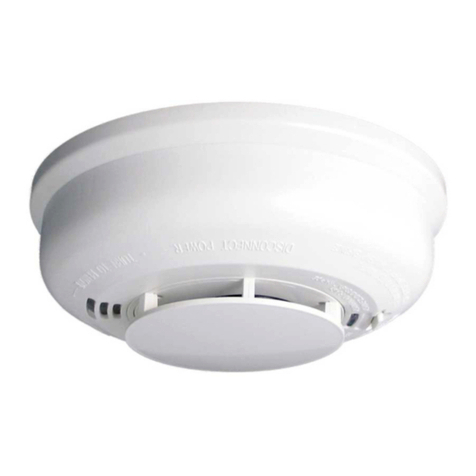
System Sensor
System Sensor 2012/24AUS Installation and maintenance instructions
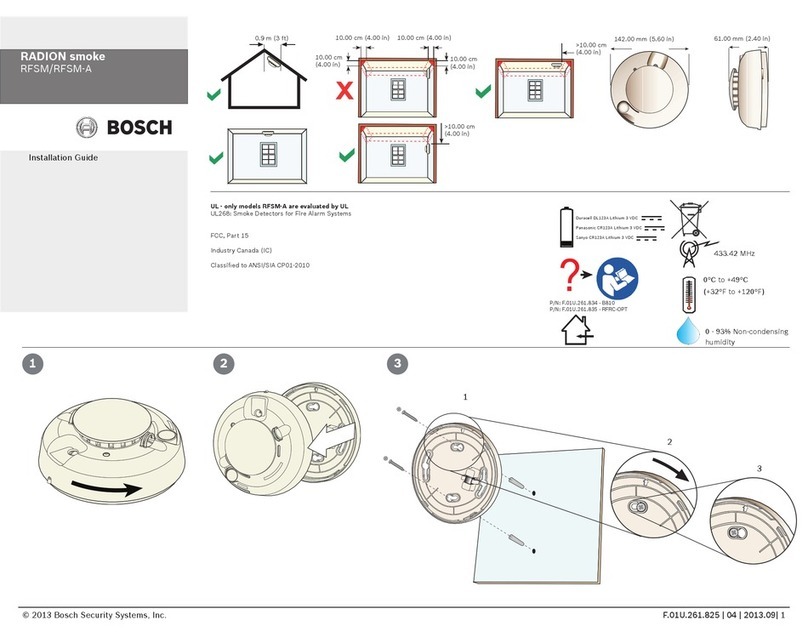
Bosch
Bosch RADION RFSM-A installation guide
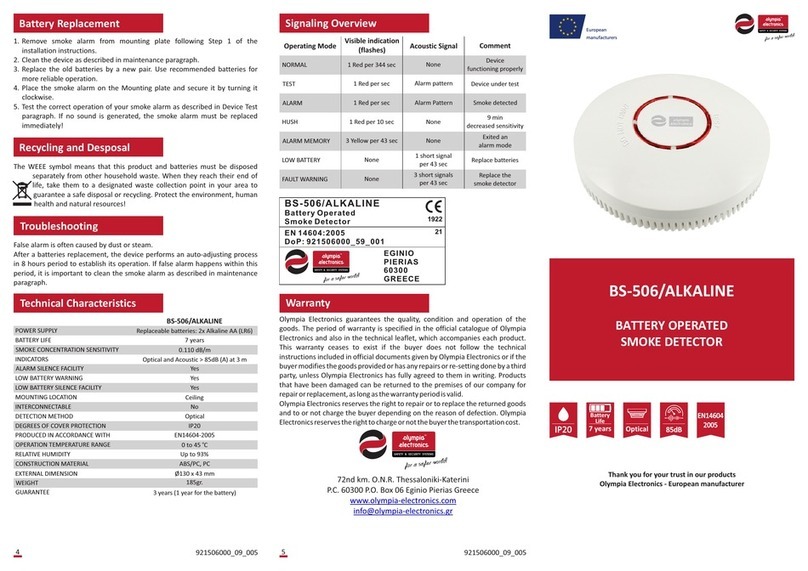
olympia electronics
olympia electronics BS-506/ALKALINE quick start guide
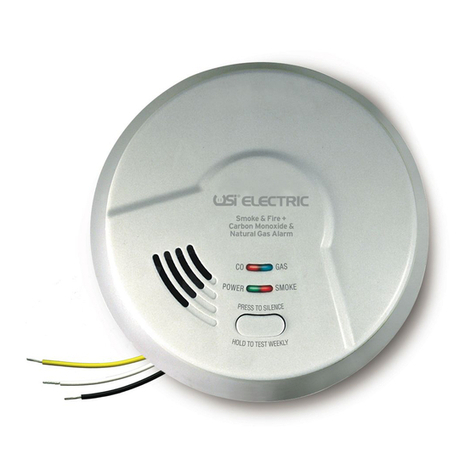
usi
usi UNIVERSAL MDSCN111CN manual
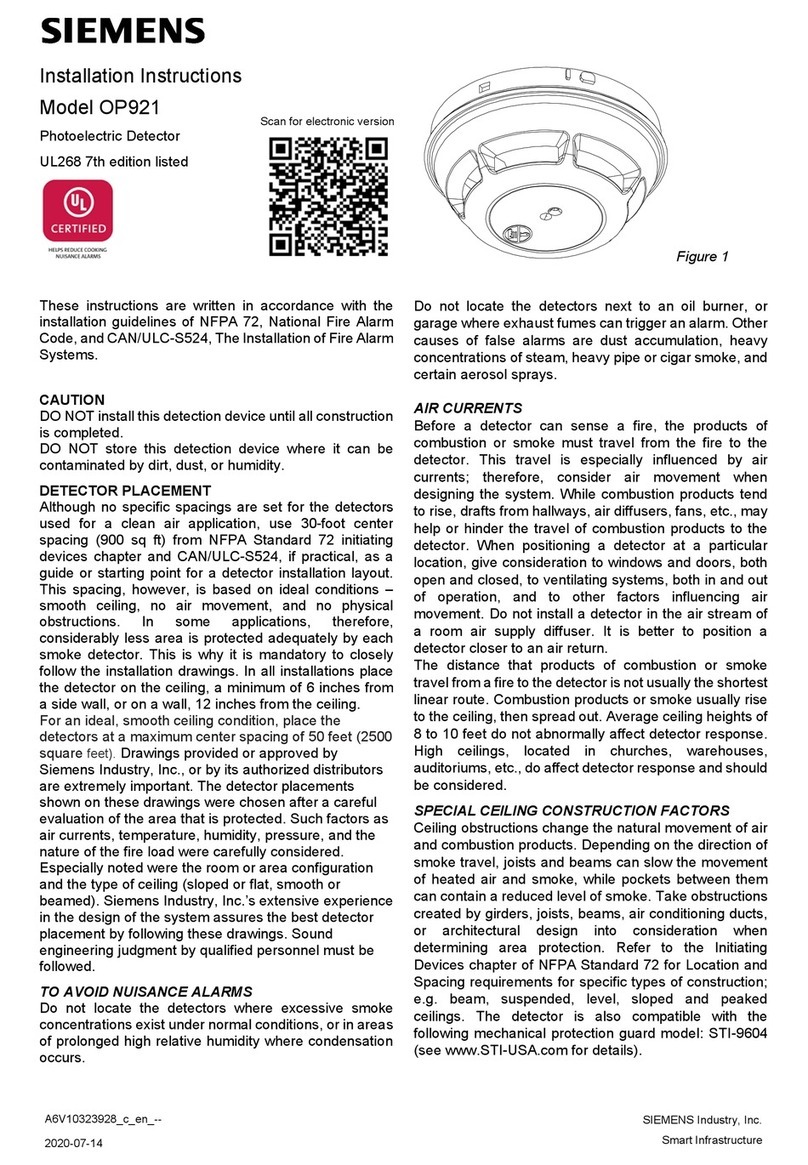
Siemens
Siemens OP921 installation instructions

Wiseup
Wiseup DVR-0031-1080P user guide

SMC Networks
SMC Networks SMCSM10-Z Guide
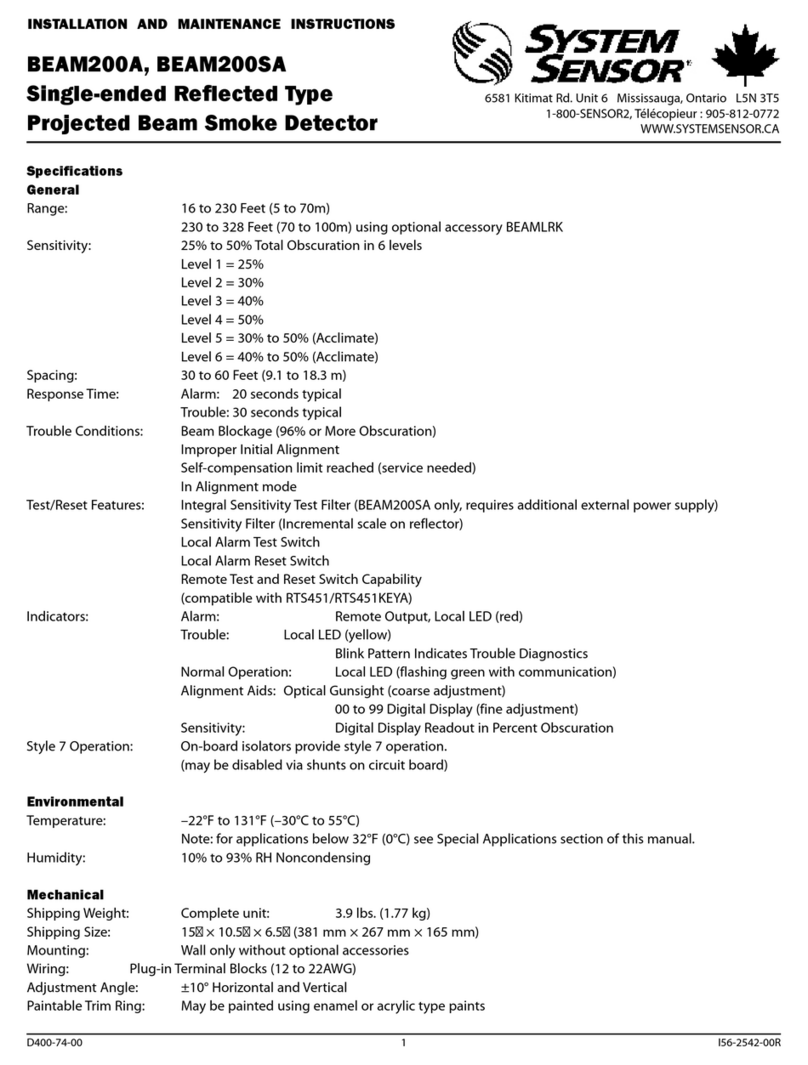
System Sensor
System Sensor BEAM200A Installation and maintenance instructions

Risco
Risco WL T33S installation instructions
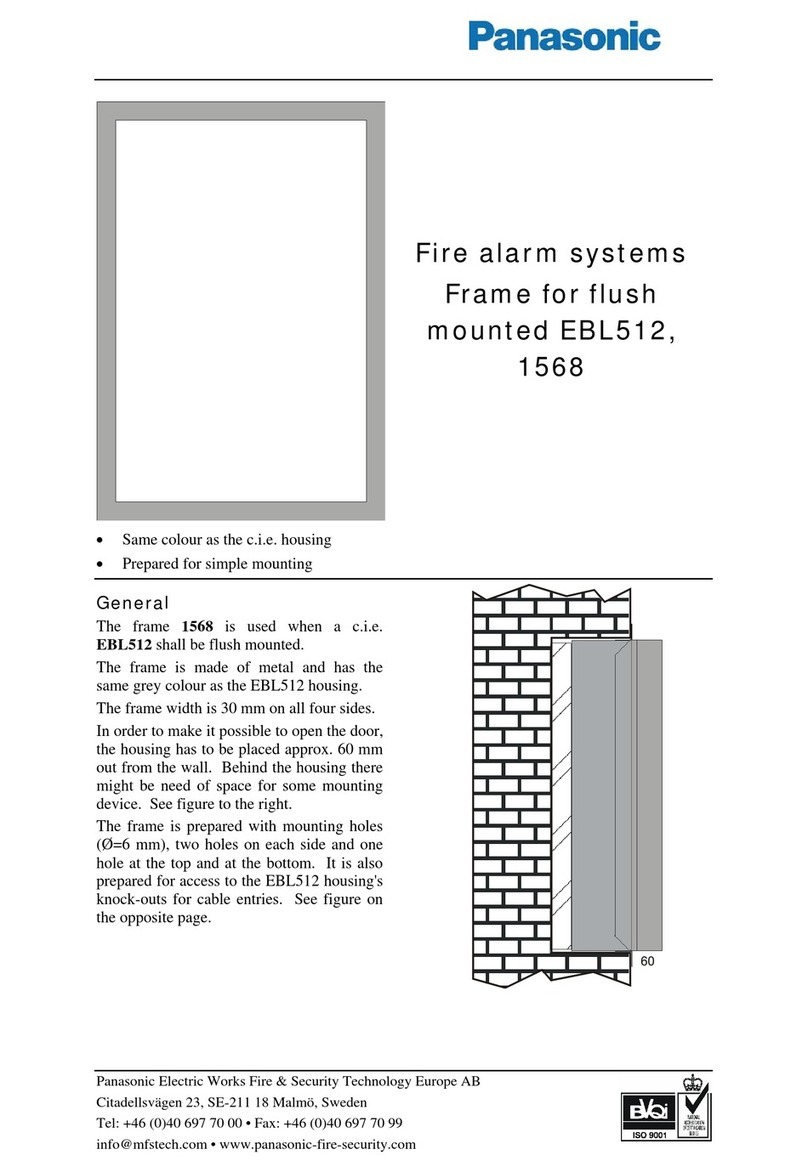
Panasonic
Panasonic EBL512 Specification sheet

COP-USA
COP-USA SDDVR-WF user guide
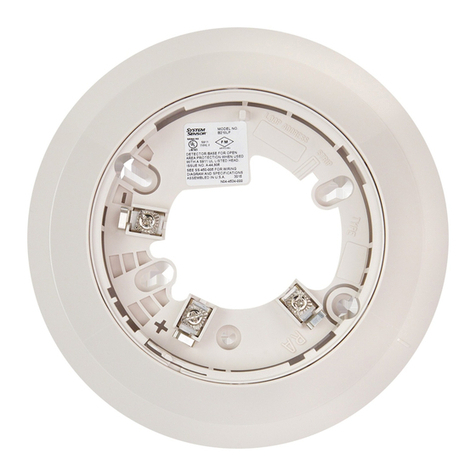
System Sensor
System Sensor B210LP Installation and maintenance instructions
